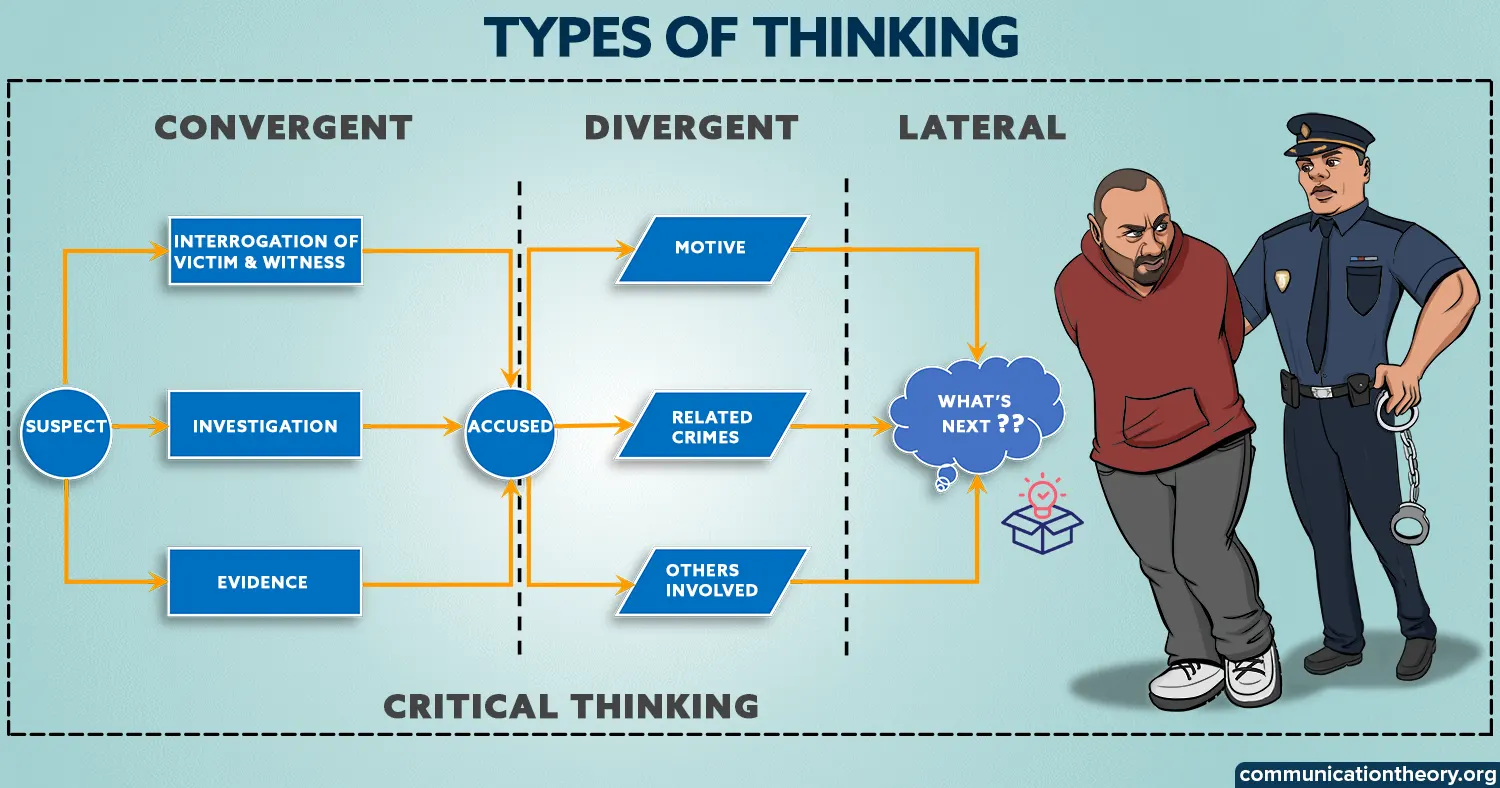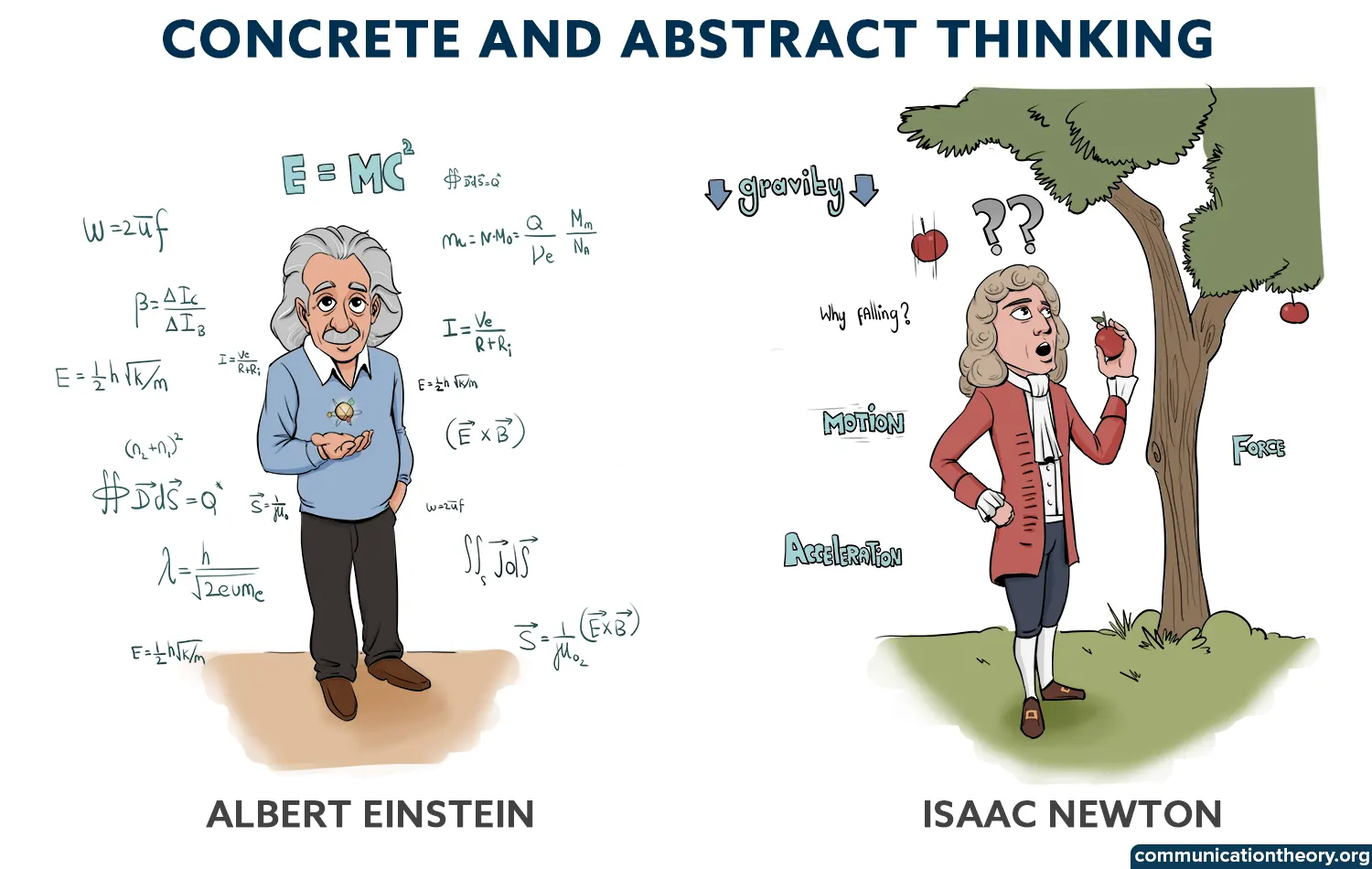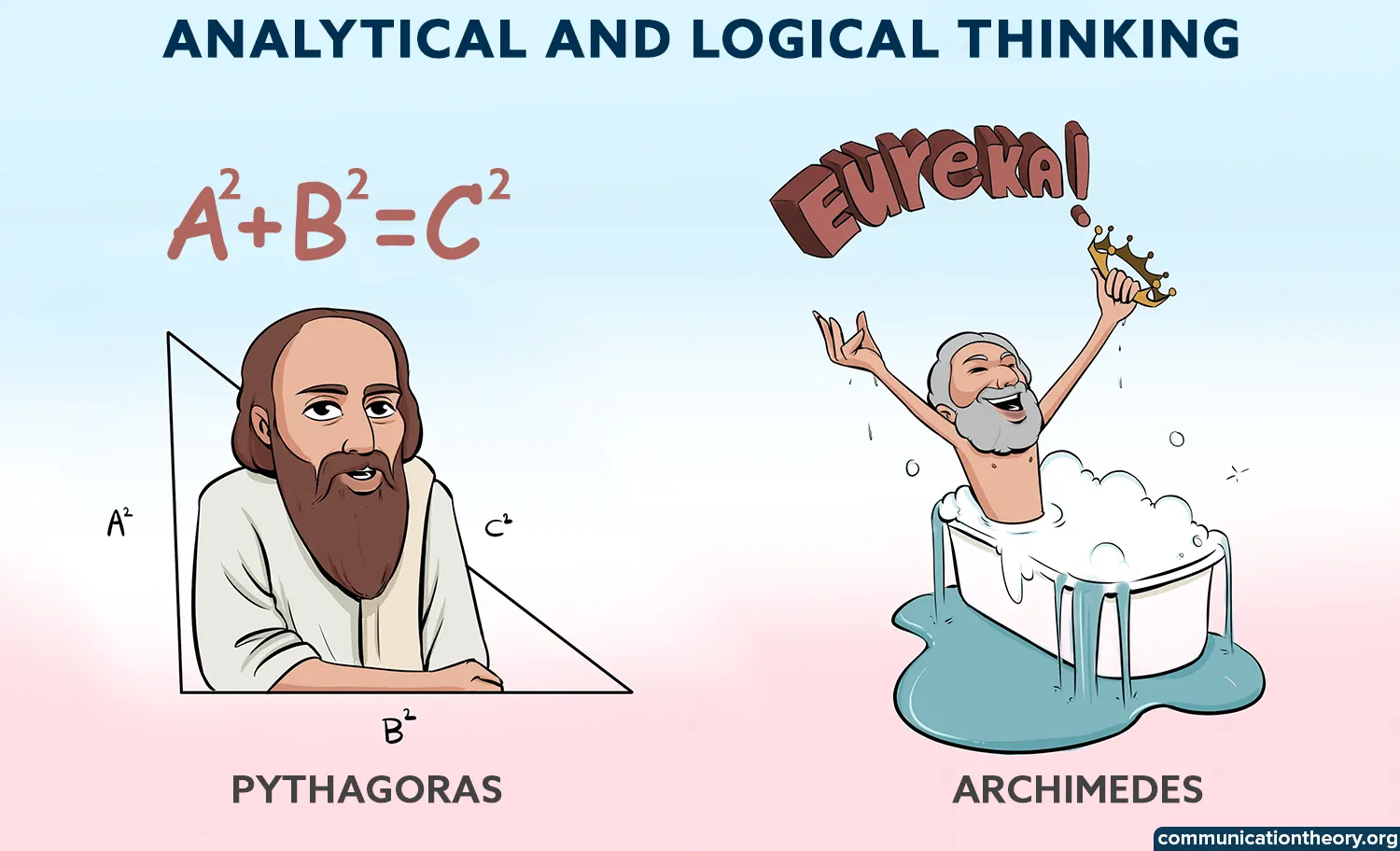Thinking is defined as a cognitive behavior in which ideas, images, and mental symbols are created (American Psychological Association). Thinking includes imagining, remembering, concept formation, daydreaming, etc.

Source: amazingmikael/Adobe Stock
There have been innumerable theories regarding the concept of thinking, including platonism, associationism, behaviorism, etc. There are also various forms or types of thinking described in academic literature. Some of them are given below.
Critical Thinking
John Dewey introduced the term critical thinking. Critical Thinking involves examining assumptions, discerning hidden values, evaluating evidence and assessing conclusions. This type of thinking utilizes an individual’s intellectual knowledge in evaluating concepts.
This thinking starts developing during 5-9 years of age and continues to develop throughout adolescence and adulthood. Critical thinkers ask questions and are inquisitive to know more. They consider the credibility of sources and can acknowledge multiple perspectives. They can question their own beliefs and are open to opposing perspectives.
For example, communicating and delegating work appropriately with co-workers requires critical thinking. The process of critical thinking uses 3 methods.
- Deduction- Deduction is used when an individual has to reach a decision based on known facts or data. These facts or data help a person to reach a valid and clear outcome.
- Induction- Induction is used when decisions can be reached through generalization. This thinking is used when an individual does not have all the information or facts. Hence, an individual notice cues or similar patterns to form a judgement or make decisions.
- Abduction- Abduction is used when an individual has insufficient information. In this case, an individual forms a decision that seems most likely to be logical based on the context and the little-known information.
For example, a police inspector has a case of catching a thief. He or she can use deduction by making a list or map of the facts that they know and can use to solve the case. If he or she does not have clear facts, they can use induction and notice if there have been similar cases before and draw a pattern to solve the case.
If he or she has insufficient information, they can use abduction by using limited information and relating it to the context or situation to conclude the case.
Creative Thinking
Galton introduced creativity as he believed it to be a part of genius individuals. Later, Guilford developed the concept of modern creative thinking. Creative thinking involves thinking in an unpredictable, unconventional manner. It involves the ability to produce ideas that are both novel and valuable.
It includes looking at an object from a different perspective. This type of thinking can be used to achieve things faster or in a better way than usual. This thinking drives human development and innovation.
The Five Components Of Creativity Include:
- Expertise: It refers to a well-developed base of knowledge. The more knowledge we have, the more we can combine and use it to innovate.
- Imaginative Thinking Skills: These skills allow an individual to view things from different, unique perspectives and to find patterns and form connections.
- A Venturesome Personality: This type of personality is characterized by seeking new experiences, dealing with ambiguities and risks and preserving through obstacles.
- Intrinsic Motivation: This motivation is about being driven more through interest, satisfaction and challenge rather than by external incentives. People who are creative focus more on pleasure and satisfaction from their work rather than impressing people or making money.
- Creative Environment: This type of environment supports and encourages creative ideas. It includes being mentored, challenged and supported by colleagues or peers. These environments emphasize innovation, team-building and communication.
Creative thinking can be encouraged through a few techniques.
- Brainstorming can be used to solve small or big issues. It is the process of interacting in a group and bouncing ideas off each other. Lots of creative ideas could provide more alternatives, which could help decision-making or problem-solving.
- Consuming different kinds of content could also help in developing creative thinking. Books, movies, and podcasts are all different forms of media that have different kinds of knowledge. If there is a problem, the solution can be found through repurposing or remixing ideas that originated from these different forms of media.
- Building a network of creativity is also a helpful measure to develop creativity. Forming a group of friends or co-workers to brainstorm once a week or even having a social book club could help in familiarizing ourselves with innovations and ideas.
For example, a teacher conducts an art competition to improve creativity in her class. She encourages all types of art and gives the freedom to students to expose their talent to whatever they want to create. This freedom and encouragement to create lead to lots of submissions of various types of art.
A teacher can explain new concepts such as space science using creative thinking. He or she can use a PowerPoint presentation with images to gain the attention of the students. He or she can also use video format or role-playing to teach new concepts. Involving the students and making the class interactive while teaching requires creative thinking.
Convergent Thinking
J. P. Guilford introduced and differentiated between convergent and divergent thinking. Convergent Thinking uses a straightforward process to reach decisions. It does not involve out-of-the box solutions. It uses previous knowledge and rules to make decisions.
It involves gathering pieces of information together to reach a logical solution or decision. It involves inward thinking. This type of thinking can be used to answer validated multiple-choice questions.
For example, putting pieces of a puzzle together or intelligence tests which require a single correct answer.

Consider How A Police Officer Turns A Suspect Into An Accused
A policeman has a suspect in a case of theft. He has some amount of information that led him to believe that the suspect is the thief. He uses inward (convergent) thinking to reach this conclusion. He does not consider multiple suspects here and reaches a quick conclusion by choosing to accuse one suspect.
This could be right but it need to be validated promptly. One needs to look for more information on various topics or in this case, suspects, to reach an informed conclusion. This thinking skill is called convergent thinking.
Divergent Thinking
Divergent Thinking is unlike convergent thinking. This type of thinking is used when there is no single correct option. New solutions or ideas are created through this thinking. Creativity requires divergent thinking. It involves breaking a topic into multiple pieces and finding alternative answers. It involves outward (divergent) thinking.
For example, A teacher asks a student to write an essay on any topic. The student has a wide array of options to choose from and can use divergent thinking to make this decision.
Lateral Thinking
Edward De Bono introduced lateral thinking and even wrote a book about it. Lateral thinking includes both convergent and divergent thinking. It includes thinking out of the box to solve problems. It is closely related to creativity.
For example, lateral thinking can be used to solve challenges that you have never come across before. Out-of-the-box solutions come from lateral thinking.

Concrete Thinking
Jean Piaget gave concrete thinking in his cognitive development theory. Concrete thinking refers to thinking in a literal form. It focuses on what is physically present in the environment. Concrete thinkers use real physical objects to understand or interpret things.
Evidence or literal proof is required to believe in a fact or statement. People who engage in concrete thinking ask a lot of questions and are inquisitive. They could also interpret the literal meanings of idioms or metaphors. This type of thinking is thinking of an object in its literal sense and not anything else.
For instance, a concrete thinker would perceive mango to be just a mango fruit. An abstract thinker would rather look at it as a food product or think of its color (raw or ripe) and other properties.
Abstract Thinking
Jean Piaget, a developmental psychologist, explained abstract thinking in his cognitive development theory. He stated that children develop abstract thinking between the ages of 11 and 16. Some gifted children could develop it at an earlier age. Others argue that abstract thinking is not an innate process. Rather, it is developed through education and cultural experiences.
Abstract Thinking is the tendency to think about objects, concepts or ideas that are not physically present at that moment or situation. It includes interpreting metaphors, analogies, and idioms as a form of abstract thinking.
For example, humor requires abstract thinking. It requires people to notice the world around them and find humor in it. This type of thinking is also a part of several intelligence tests. It is also related to creativity and problem-solving.
Sequential Thinking
John Watson, Washburn, and other behaviorists explained sequential thinking. Sequential thinking involves processing information in an organized, fixed manner. It refers to a hierarchy, in the sense that one step should be completed before reaching the second step. This type of thinking follows a sequential order.
For example, Emily is drawing a human figure. She starts from the head and the eyes and then moves on to the bottom parts.
Holistic Thinking
Smuts is considered as the developer of holism. Holistic Thinking involves imagining the bigger picture and acting accordingly. This type of thinking does not involve thinking in a single direction, it focuses on multiple directions simultaneously. Holistic thinking states that everything is connected.
For example, a therapist might focus on an individual’s whole life (family, friends, relationships, work) to understand them rather than a single aspect.

Analytical Thinking
Kant introduced the term analytical thinking. Analytical thinking refers to examining or evaluating parts of a concept or idea. This type of thinking involves paying attention to details. It includes comparing alternatives to reach a correct decision.
For example, researching any concept requires analytical thinking. It is an important skill to be used at the workplace for solving complicated problems, making logical decisions and executing important project goals.
Analytical thinking can be developed by:
- Being observant and noticing details of one’s environment. Staying vigilant can help in engaging the mind actively.
- Reading books can also help develop analytical thinking. Evaluating the reading material and coming up with questions is a helpful tactic.
- Playing brain games such as puzzles or chess can also help, it could challenge the brain to remain active and aware.
Research Evidence
Study By: David Santos, Blanca Requero, Manuel-Martin Fernandez
Aim: To study individuals’ thinking style (holistic vs. analytic) and its relationship with the way they deal with contradictory information and whether experiencing mixed emotions can mediate this relationship.
Method:
- Participants were asked to fill out a questionnaire that measured their thinking style (holistic or analytic).
- Post-filling, they were exposed to 2 opposing pieces of information, which were 2 contradicting statements. Then, they had to state how much they believed each of the statements to be true.
- It was assumed that participants with a holistic style of thinking would be more willing to compromise towards opposing information than participants with an analytical style of thinking.
- The compromise approach was measured in the sense that how much did the participants believe both statements to be reasonable or believable?
Results:
- It was found that people with holistic thinking found both statements to be more believable than people with analytical thinking.
- It was also found that participants with holistic thinking experienced more mixed emotions than people with analytical thinking. This could have affected their decisions about the contradicting statements.
Real-Life Examples Of Using Various Types Of Thinking
Homoeopathy is an impactful field of medicine. Samuel Hahnemann is the founder of homoeopathy. He had a medical degree and worked as a physician for 15 years, during which he struggled to earn. He came up with this innovation while consuming regular doses of cinchona (bark).
Lateral thinking was used to support this out-of-the-box idea. He found that it produced all the symptoms of malaria (mild ones). This made him write a paper, which required research and analytical thinking. With time and more lateral thinking, he came up with homoeopathy.
He gave several vaccinations and cures for diseases and used creative thinking to come up with these ideas. He was not interested in pathology and was only into homoeopathy. He used inward, convergent thinking here. Over time, homoeopathy became popular and a lot of institutions opened up for further research and education in this field.
Conclusion
Individuals use different styles of thinking under various life instances. They can use convergent thinking to answer questions in an exam, apply creative thinking to solve a problem and use analytical thinking to research a subject. This thinking process keeps developing throughout our life span, as we have new experiences and learn through them.
An individual can possess two or more types of thinking. They can have both convergent and divergent thinking abilities and can use them according to different contexts.
Tips and Tricks
- Thinking requires questioning assumptions and own biases. To make your thinking skills better, it is advisable to not fall prey to your own biases and be open to several perspectives.
- Consuming different forms of media, reading books from different genres and interacting with people different from you can help in broadening perspectives and gaining more knowledge.
- When you come across an article or any sort of information, do not believe in it blindly. It is helpful to question information before completely believing it. Reading and finding more information from multiple sources can give you more ideas so that you can form an informed decision or opinion.
- It is helpful to be empathetic. Putting yourself in other people’s shoes can help in developing better thinking skills. Empathy makes you a better person and a better negotiator.
- Playing puzzles, mazes, crosswords and sudoku and other thinking-related games including memory games can help in sharpening the brain and keeping it active.